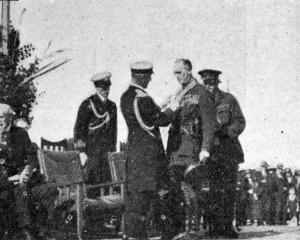
The women, apparently, took the doorkeepers by surprise. They assembled on the steps of Parliament House at 3 p.m., and marched into the outer hall. Here the leaders made impassioned speeches.
The women were told that they were of the starving unemployed - that they could not get work, and that the Government was keeping food prices at a criminally high level. Then the women tried to get into the large chamber known as the Queen's Hall.
Frantic messages from the overwhelmed doorkeepers had brought reinforcements, and the doors were held successfully. Then Miss Pankhurst, with the prescience of her breed, headed a rush through a door labelled ''Members only'', and in a moment the excited creatures were clawing at a solid door which led immediately into the Legislative Chamber itself.
''We want Hughes!'' ''Adjourn the House!'' ''Give us work!'' were the shrieks that penetrated into the chamber and brought the solemn proceedings there to a sudden, deathly pause.
Messengers, doorkeepers, and lackeys dashed round and headed off the women at the door. There were shrieks, howls, and wild imprecations. But masculinity prevailed. Miss Pankhurst and her agitated followers were hustled along the corridor and out into the vestibule. Reinforced by her main body of supporters, Miss Pankhurst climbed on a chair, and started to lash the women into a new frenzy by the fury of her eloquence. But stolid policemen moved forward, and the heroine of a thousand suffragette battles lost her chair . . .
Baulked of their prey, the women slowly dispersed. While a few groups were still lingering, arguing in threatening language, a party of 12 policemen came panting up from an adjoining station. Even these hardened upholders of order looked a little sheepish under the torrent of abuse, ridicule, and derisive laughter which the women turned upon them.
Maori population
The total Maori population, according to the census taken in October, was 49,776. A paper laid on the table of the House this afternoon by the Native Minister states that since 1901 the figures show an increase until the last census, when a decrease of 68, as compared with 1911, was shown.
How far the figures on this occasion are affected by enlistment it is difficult to say, but they must be affected to some extent. The enumerators for the North Island - particularly the Taranaki and Waikato districts - report that some difficulty was experienced in obtaining information owing to the fear on the part of the Natives that the statistics were being obtained for the purpose of recruiting.
The enumerators generally report that with the exception of the smallpox epidemic in 1913, and some cases of typhoid, the health of the natives has been generally good, and that in most districts there has been a continued improvement in the habits of life and industry of the Maoris, especially in districts where land is being opened up and settlement advancing, giving greater opportunities of employment, etc.
- ODT, 16.8.1917.
COPIES OF PICTURE AVAILABLE FROM ODT FRONT OFFICE, LOWER STUART ST, OR WWW.OTAGOIMAGES.CO.NZ












